
 Back to System Manual Page
Back to System Manual Page
Last update: 4.12.1995 19:24 Kaj
Q.931 module
Contents:
Messages that come from the network layer can be split into four groups.
We have: call setup, call information, call clearing and miscellaneous. These
groups form a basis for the splitting of Q.931 into modules. Besides of these
four modules we need a couple more to make it complete. We need one module
for communication between Q.931 and the user application, and one module
that takes care of the communication between Q.931 and Q.921. The former
is called the socket module and the latter the DLPI module. The names come
from the way interfaces upwards and downwards are implemented. Here is the
whole picture.
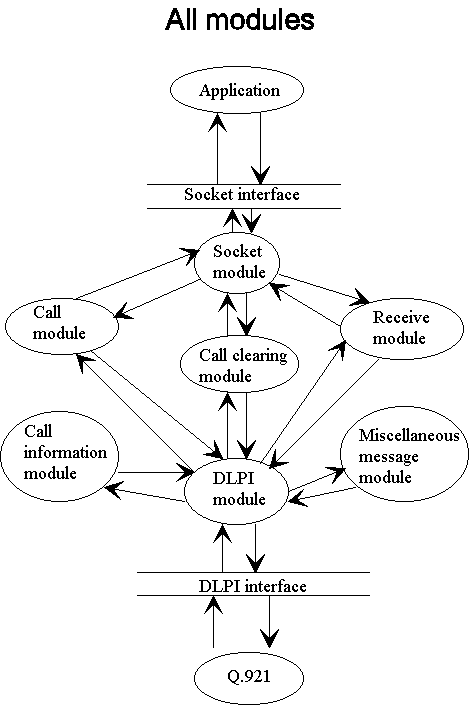
Picture:Q.931 modules.
The socket module takes care of communication between Q.931 and
the user application. Q.931 serves as a socket server that listens for incoming
calls and the application serves as a client requesting services. The functions
this module handles are as follows. First we must initialize the socket structure
with the right kind of information. This includes hostnames, socket numbers,
addresses and so on. After that, the socket must be created. It must then be
bound to a certain service port. Thereafter it has to be prepared for incoming
calls. After that we can wait for connections. Once a connection has been
established, can we read data out of the socket. The socket module invokes
the right module depending on what the user wants. This is how the module
looks like. Basic funktions are also shown.
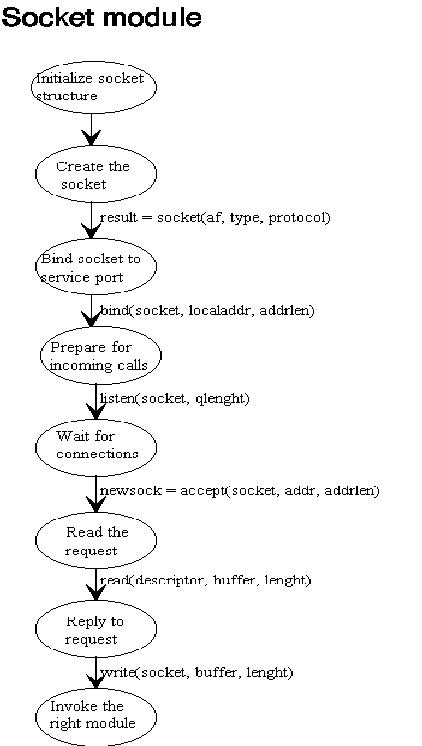
Picture:Q.931 socket module.
The DLPI module takes care of communication between Q.931 and Q.921
throuh the DLPI interface.
Read more about DLPI here
The call module is the one that invokes a call. Each module can be in different
states depending on which part of the call is processed. At the beginning we
usually start from the null state. In case of a call setup the following thing to
do, is to send a primitive down to the data-link layer containing a SETUP.
All data is sent with the DL_DATA.request primitives. After that we are in
the call initiated state. When the network receives our SETUP, it sends us
a CALL PROCEEDING message, and we can move to outgoing call
proceeding state. When the phone rings at the other end, we receive an ALERT
message. The next state to go to, is the call delivered state, which indicates that
our call has reached the called party. After receiving a CONNECT message,
the active state follows. In this state user information is being transferred.
In case of errors and if we cannot get any answers, the call clearing module is
called. The following picture shows the operation of the call module.
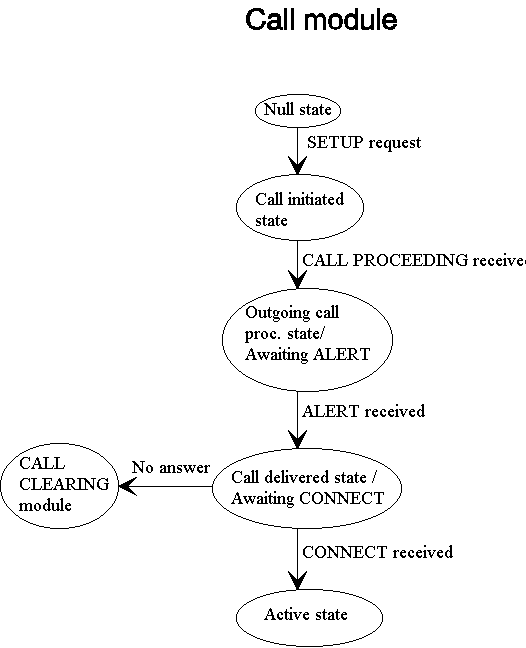
Picture:Q.931 call module.
This module sends and receives the following messages:
- SETUP
- CALL PROCEEDING
- ALERT
- CONNECT
And it can be in one of the following states:
- Null state
- Call initiated state
- Outgoing call proceeding state
- Call delivered state
- Active state
The receive module is the one that takes care of an incoming call. The module
also begins from from null state and is waiting for an incoming SETUP message.
Once received, it moves to call present state. This state can notice that the B-channel requested in the setup message is not available. If this is the case
is sends a RELEASE COMPLETE message and enters null state. Otherwise
it sends CALL PROCEEDING to the network indicating the call has been
accepted. The next state is the incoming call proceeding state. ALERT is
sent to the network, and state transition to call received state occurs.
Once the user picks up the handset or makes other possible actions, a
CONNECT message is sent. Connect request is the next state. This state
starts timer T313. Once CONNECT ACKNOWLEDGE has been
received from the network, timer T313 is stopped and the module is in
active state. The following picture shows the operation of the receive module.
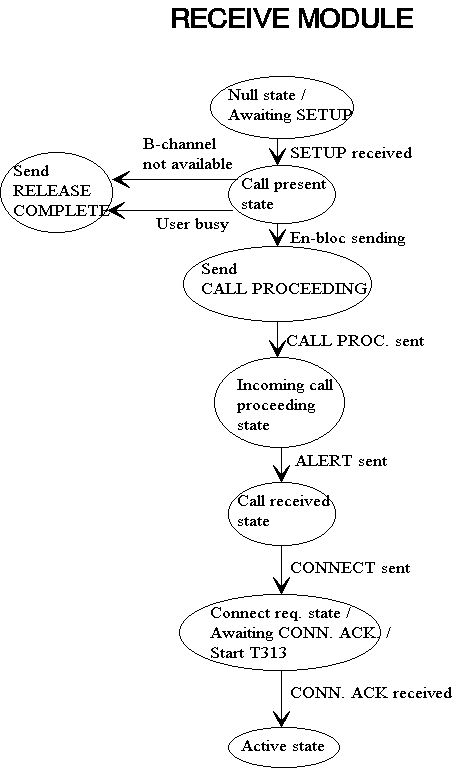
Picture:Q.931 receive module.
This module sends and receives the following messages:
- SETUP
- CALL PROCEEDING
- ALERT
- CONNECT
- CONNECT ACKNOWLEDGE
And can be in one of the following states:
- Null state
- Call present state
- Incoming call proceeding state
- Call received state
- Connect request state
- Active state
The call clearing module takes care of terminating the call. This can be
done in three different ways. The two most common are when either the user or the
network requests a termination. The third option is a faultsituation which leads to disconnection.
When the user needs to disconnect, a DISCONNECT message is sent to the network. Disconnect
request state is entered and timer T305 is started. The user disconnects the B-channel and
waits for RELEASE message from the network. Note that disconnecting the B-channel doesn´t
mean that it is ready for furher use. It needs also to be released in order to be available.
If the user receives a RELEASE from the network it stops timer T305, releases the B-channel
and sends RELEASE COMPLETE to the network. Thereafter it enters null state.
If timer T305 expires, which means that the network has troubes in sending a REALEASE,
timer T308 is started and a RELEASE message is sent to the network. Release request state
is entered. If T308 expires once again, the B-channel is placed in maintainance condition and the call
reference value is released, after which null state is entered. If RELEASE is received the procedure is the
same as described above.
If a DISCONNECT is received from the network, the user shall disconnect the B-channel,
start timer T308 and send a RELEASE message and thereafter enter the release request state.
If the network sends a RELEASE COMPLETE message, timer T308 shall be stopped and both
the B-channel and call reference number shall be released. Null state is entered. If timer T308 expires,
the user shall send a RELEASE message to the network, restart T308 and enter release request state.
If T308 expires once again, the B-channel shall be placed in maintainance condition and the call reference
value shall be released. If RELEASE COMPLETE is received, T308 is stopped, B-channel and call
reference value are released and null state is entered.
Here is the picture.
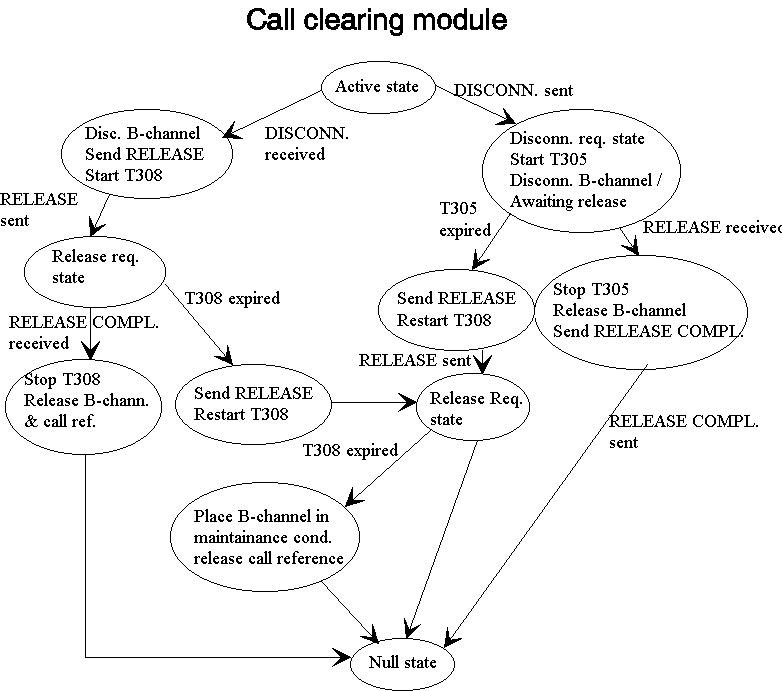
Picture:Call clearing module.
This module sends and receives the folloving messages:
- DISCONNECT
- RELEASE
- RELEASE COMPLETE
And this module is in one of the following states:
- Disconnect request state
- Release request state
The call information module takes care of call suspention and resuming. A user
can requets call suspention by sending a SUSPEND request to the network. In that case,
suspend request state shall be entered and timer T319 started. If SUSPEND ACKNOWLEDGE is
received, T319 is stopped and B-channel is released. The network can also respond with a SUSPEND
REJECT message. If that is the case, active state is entered. If timer T319 expires, active state is
also entered.
When the call needs to be refreshed, the user sends a RESUME message to the network. Resume
request state is entered and timer T318 is started. If RESUME ACKNOWLEDGE is received, T318 is
stopped and active state is entered. The resume request can also be rejected, and null state is entered. If timer
T318 expires, call clearing is invoked.
The following picture shows the procedures.
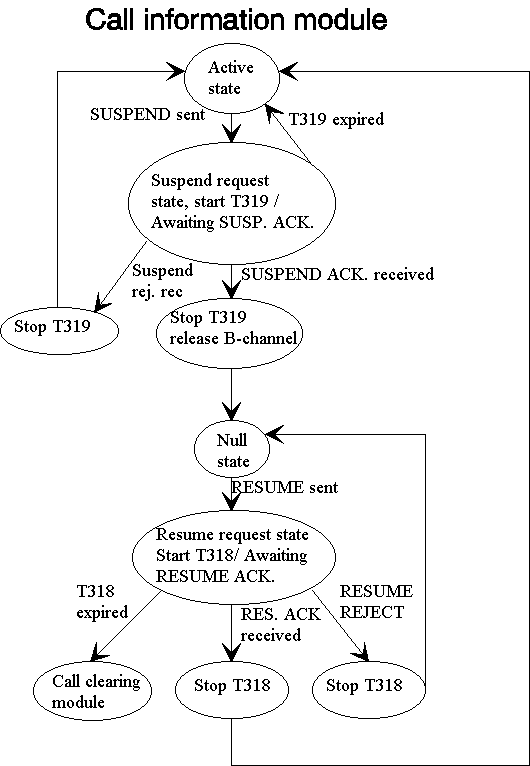
Picture:Call information module.
This module sends and receives the following messages:
- SUSPEND
- SUSPEND ACKNOWLEDGE
- SUSPEND REJECT
- RESUME
- RESUME ACKNOWLEDGE
- RESUME REJECT
And this module is in one of the following states:
- Suspend request state
- Resume request state
The miscellaneous module handles requests for status messages.
A STATUS message is sent as a response to a STATUS ENQUIRY message or at any
time during a call to report error conditions. It is mandatory to send response to
a status enquiry message.
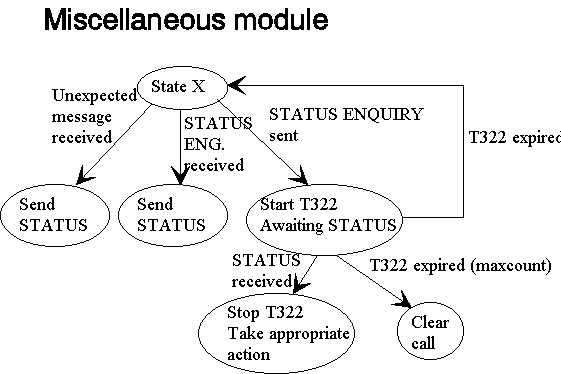
Picture:Miscellaneous module.


 Back to System Manual Page
Back to System Manual Page





